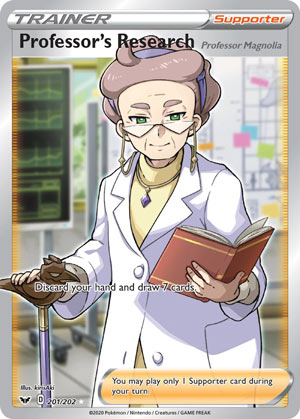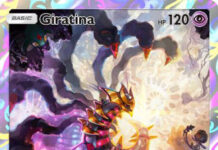
Professor’s Research
– Sword & Shield
Date Reviewed:
February 21, 2020
Ratings Summary:
Standard: 5.00
Expanded: 5.00
Limited: 5.00
Theme: 5.00
Ratings are based on a 1 to 5 scale. 1 is horrible. 3 is average. 5 is great.
Reviews Below:
 Otaku Our number one pick for the latest set is Professor’s Research (Sword & Shield 178/202, 201/202, 209/202)! There’s something really bothering me about this card, but it will take some setting up to explain. Let us begin with what Professor’s Research is and what it does: this is a Trainer-Supporter that has you discard your hand, then draw seven cards. It is also worth noting that, after the card’s name (“Professor’s Research”) is smaller, fainter text that reads “Professor Magnolia”, who is the character featured in the art of all copies of Professor’s Research we’ve seen so far. Professor’s Research is a new card, but in name only. Other than her name, mechanically she’s the same as Professor Juniper (released about nine years ago) and Professor Sycamore (released six years ago). In fact, is has been less than two full years since the last set containing Professor Sycamore rotated from the Standard Format! This is how we know that discarding your entire hand to draw seven cards off of a Supporter is a great effect. Most, perhaps all, competitive decks will need to rework themselves to work with having to discard the hand. This will likely favor certain strategies, shaping the metagame. The T1 rules might be able to keep things from getting too crazy, but the only surprise I had when seeing how many Japanese decks were running Professor’s Research is that it wasn’t the four-in-every-deck staple that Quick Ball had managed in my small sample size. I don’t have any data for the Expanded Format post-Sword & Shield, but Professor Juniper or Professor Sycamore were in most decks. More decks than I expected are doing well without either, but approximately 75% appear to include it, ranging from a single copy to a full four of one or the other. Why not both? That is where we come to what annoys me. Unique just to Professor Juniper, Professor Sycamore, and to Professor’s Research, is a rule that prohibits you running them together, in the same deck. As I’ve mentioned before in this review: why not just issue an errata so that they all have the same name? That is far more streamlined than having to remember a special rule that applies to these “Same stats, same effect, different name” cards but which does not apply to any other examples of this phenomena. My idea of also including the original Professor Oak in their may have been reaching, but what would one more errata for the list have mattered compared to having to update that “special rule”? Getting back to Professor’s Research’s actual performance, in Expanded it joins the ranks of Professor Juniper and Professor Sycamore. In terms of my scoring, Professor Juniper, Professor Sycamore, and Professor’s Research all benefit both from my recent approach whole number (out of five) scores, and how fewer decks are relying on just VS Seeker to spam a single copy of their main draw Supporter. For the Limited Format, this is a draw Supporter; if you pull Professor’s Research, you run it. If you somehow pull more than three, maybe don’t run the extras, or run them but remember not to actually use them all. Even with just one, mind how many cards you have left in your deck, and what you’ll be tossing; card recycling effects are far less abundant here than in Constructed. Speaking of which, that brings us to something that surprised me? Professor’s Research actually is not as good as I expected in the new Theme Decks! “Cinderace Deck”, “Inteleon Deck”, and “Rillaboom Deck” all have simple, descriptive names instead of the usual fare, but each comes with three copies of Professor’s Research. They’re built in a manner where you’ll often have to choose between discarding cards you’d rather keep in your hand, or just sitting on Professor’s Research and hoping things work out better next turn. It wasn’t uncommon for me to end the game with one or two Professor’s Research in my hand, win or lose. Professor’s Research is still a good card to have, I just wish we had more than one Ordinary Rod in the deck, a Pal Pad, and/or some form of shuffle-draw. Ratings
Another set of three fives-out-of-fives, though with a four-out-of-five tacked on because Professor’s Research is actually available in the new Theme Decks. As I wrote this, I actually was expecting to have lower scores, but then I realized Supporters weren’t as scarce in lists as they had been in Expanded. Professor’s Research will push the game towards decks with easily spent hands, or perhaps with nice card recycling options. A few competitive decks will be able to buck this trend, as we still have cards like Cynthia and Marnie to use instead, but those two also work well with Professor’s Research. All three of us had Professor’s Research as our top pick! |
 Vince Professor’s Research Ratings: (Edit: finally decided on giving perfect scores across the board.)
Details: Meet the new Professor, same as the old Professor!!! After we bid farewell to Professor Sycamore at the end of the 2017-2018 rotation, Professor Magnolia – Professor’s Research from Sword & Shield – picks up where he left off a year and a half ago. And what does she do? Same thing Professor Oak/Juniper/Sycamore did since day one of the Pokémon TCG: Discard your hand and draw 7 cards! If you read all the previous reviews of such Professors in the Pojo site, you’ll understand why Professor Magnolia takes first place. And it’s unanimous too; all three reviewers (including myself) picked it as their number one card. This is the one of the best Supporter cards in any format, with Marnie being a close second. Does every deck need one? It depends. Some would run a full four if they wanted to tear through their deck as fast as possible and not care about what’s gonna be discarded. Other decks want to conserve cards that they can use later on, and Marnie from yesterday’s review serves them well. Because of that, such Professor cards weren’t what they once were in terms of universal usage; they face too much competition from other draw based and search based Supporters. You also have to be mindful of what’s being discarded because while there are some recovery cards, they can only recover certain cards. There’s no card like Lysandre’s Trump Card that can save you. Might as well use whatever you can from your current hand before you decide to dump them all. Other things that nerf this card besides the decision of the player is that, just like Marnie, it is a Holo Rare, making it harder to pull from packs. Professor Juniper and Sycamore are both uncommons, but they are Expanded legal. However, despite being a Holo Rare, you have many opportunities to grab a couple of those. Each Galar Starter Theme Decks contain exactly 3 Professor’s Research and the Build & Battle boxes also gives you a chance to pull her (between zero to two copies per 23 card evolution packs). They’re aren’t Holo Rare cards in this case, but she is still a legitimate card per se. Another thing to point out in Expanded is that you cannot have the other Professors in the same deck. It’s also unfortunate that you can’t use her on the first turn of the game due to not being able to play Supporters. Despite small drawbacks, it’s hard to argue about a card that consistently nets you seven cards and not rely on other variables (like Whitney or Colress). There might not be enough to run a full four in certain circumstances due to intense competition from other Supporters nowadays, but you certainly have room to run at least two of them. Let’s not forget that Dedenne-GX’s Dedechange ability does a similar thing, albeit drawing one fewer card. But when you combine Dedenne-GX and the professor together, then you could potentially dig through 13 cards from your deck in one turn, and we haven’t factored in other cards that provides search and draw power, letting you dig even further!!! I don’t recall a format where there were no draw/search based Supporters, which is a testament as to why decks need lots of draw based cards. It keeps your deck running, or otherwise you won’t be able to do much if the only draw power you have is drawing a card at the beginning of your turn. Yeah, that’ll take forever! |
 aroramage …oh like you’re surprised. Professor’s Research, aka Professor Sycamore, aka Professor Juniper, aka Professor Oak, aka Professor Magnolia for this generation, is the same Supporter you all know and love, just now officially named as such to group all these different Supporters together so they wouldn’t have to keep writing out a rule to prevent you from running Sycamore, Juniper, and Magnolia all in the same deck in Expanded. If you don’t know what any of these cards do for some reason, basically you discard the rest of your hand if any and then draw 7 cards. This effect has seen monumental play over the course of its history in the game, so it should be no surprise that it got ranked so highly on our list. We haven’t had this effect in Standard for a surprisingly long time though, but generally speaking when it’s available, a lot of stuff happens. Decks become a lot faster, Energy acceleration becomes more centered around the discard pile (as do many other aspects of the game), and games play out more quickly as a result. By this point, you’ve probably seen how quickly Professor’s Research has changed the competitive landscape, since this is the kind of effect players love to have! So yeah, if you’re not convinced that Professor’s Research can do wonders for your deck, just look around! We have years of history with this card, under one name or another, that’ll tell you how good it is. Certainly we don’t have to sing its praises – we’ve already talked about Professor Sycamore AND Professor Juniper enough in their own right, and even Professor Oak has a couple reviews to his name! So check em out, see what we’ve said across the ages, and remember: always run 4 copies in your deck. Rating Standard: 5/5 (absolutely the go-to draw Supporter of the format) Expanded: 5/5 (already a popular card here by other names, so make sure you’re not running more than 4 total) Limited: 5/5 (obviously) Arora Notealus: By all accounts, this is probably the “golden standard” when it comes to the power level of Supporters in any age. For what all the card does in the game, “discard your hand, draw 7” is basically one of the best effects a Supporter can have. The flexibility, the draw acceleration, the sheer power of this ability – it’s just hard to describe with words, so just try it for yourself! In fact, compare using this card to something like Cynthia from the previous formats, and you’ll start to see the major differences. Weekend Thought: Do you agree with our list? Will older cards returning or with revised effects be dominant? Do Pokemon-V intrigue you enough to give them a whirl? Are VMAX the new Tag Team-GX, or is it just its own thing? Would you put some other cards higher on the list? Would you take some off? |
We would love more volunteers to help us with our Card of the Day reviews. If you want to share your ideas on cards with other fans, feel free to drop us an email. We’d be happy to link back to your blog / YouTube Channel / etc. 😉
Click here to read our Pokémon Card of the Day Archive. We have reviewed more than 3500 Pokemon cards over the last 17+ years!



